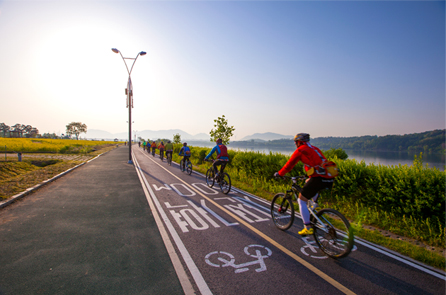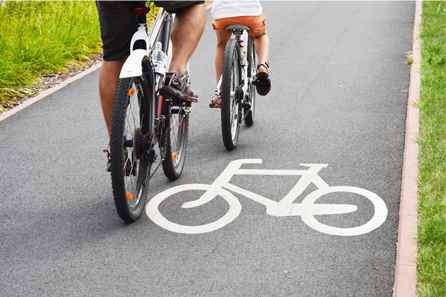General Information
Happy safety riding with bicycle sharing happiness
General Information
Bicycle riding principlesBicycle paths and general roadsUnder the Road Traffic Act, a bicycle is classified as a 'vehicle'. On roads that have separate vehicle lanes and sidewalks, bicycles are required to ride in the vehicle lanes. 
Keep rightBicycles on roads should use the outside lane on the right. To avoid danger from passing cars on the left, cyclists should always dismount to the right side of their bicycles flat land, and 3 bicycle-lengths or more on a downhill. Crossing the roadWhere there is no special bicycle crossing, the bicycle should approach the intersection in the right lane, dismount and walk his bicycle across the pedestrian crosswalk. If there is a specific bicycle crossing, the cyclist can ride across. Passing parked and slow-moving vehiclesWhen passing a parked or slow-moving vehicle, the cyclist should slow down and leave enough space for a door to open or the car to start. Starling and stoppingThe bicycle should be completely stopped when the cyclist starts out or dismounts. Before starting, check to the rear for safety. Safe distanceThe cyclist should always leave a safe distance between car and bicycle. This should be one bicycle-length (approximately 3m) on flat land, and 3 bicycle-lengths or more on a downhill. Caution on intersectionThe cyclist should use a hand signal to show direction at least 30m before the intersection. It is prudent to look to both sides care-fully and to slow down or stop before entering the intersection. Going straightBefore entering the intersection, the cyclist should watch out for vehicles making right turns. After going through the intersection, the cyclist should watch out for all vehicles. It may be dangerous to pass through an intersection just before the signal changes, and better to wait for the next signal. Lett turnWhere there is a traffic, signal, the safest approach is to go straight through the inter-section in the far right lane, and wait for the signal to change to cross the road. Right turnThe cyclist should stay in the far right lane, and should slow down and watch for pedestrians crossing the road. The cyclist should not make the right turn at the same time as a car. 
Caution when brakingThe bicycle has front and rear brakes. When reducing speed, slowly engage the rear brake. When stopping, the cyclist should use both brakes at the same time. Caution when parkingWhen parking a bicycle, make sure it does not interfere with pedestrian traffic flow if you lock it to a tree, fence or the like. It is best to use a designated bicycle parking lot or parking rack, and to lock the front wheel, bicycle body and rear wheel to the parking rack. For combination locks avoid the use of a password that is too obvious. Safe attireWhen riding on the road, the cyclist should wear bright colored-clothes, with a safety vest and a bicycle helmet with reflector. If the pant leg is too wide, fasten it with a band or clip. Wear shoes without laces if possible, or tie the laces securely. Do not wear a hat or scarf that the wind could be blow across your eyes or carry away. Try notto ride when it rains, but if you do, wear a raincoat and do not use an umbrella. Instructions for using bicycle gearsGears are used to maintain efficiency in varying terrain and wind conditions. There are generally both front and rear gear mechanisms operated by controls on the handlebars. 
The chain should be in as straight line as possible between the front and rear chainwheels. How to deal with accidentsAccidents involving bicycles ate traffic accidents, and it is necessary to comply with all applicable traffic laws and regulations. Bicycle accidents causing property damage onlyBicycle-bicycle and bicycle-car accidents that result in property damage only (no personal injury) do not need to be reported to the police, unless there is a problem resolving the matter through the insurance company. Bicycle accidents causing personal injuryIf a person is injured as a result of a bicycle accident. provide assistance and report the accident by telephone to 119 and 112. Don't change anything at the scene of the accident and obtain contact information from witnesses to the accident. |